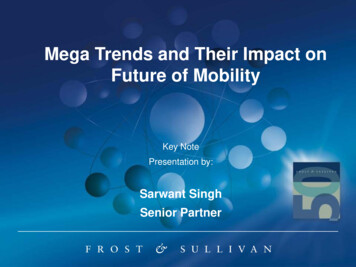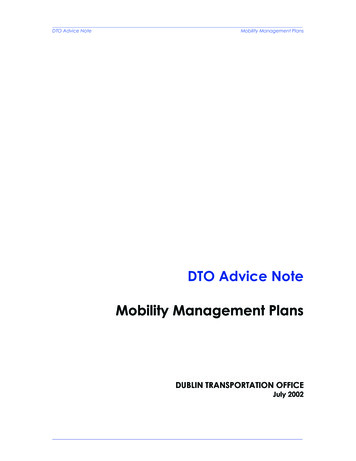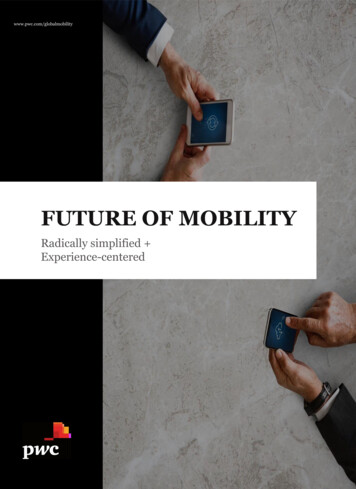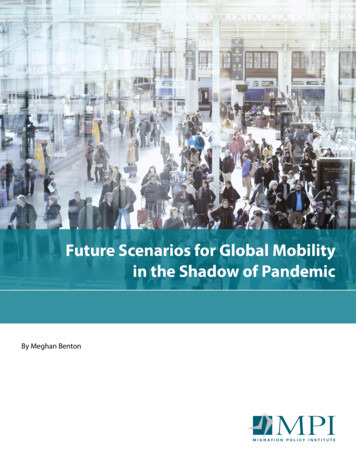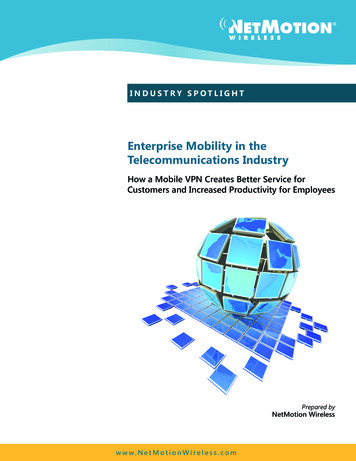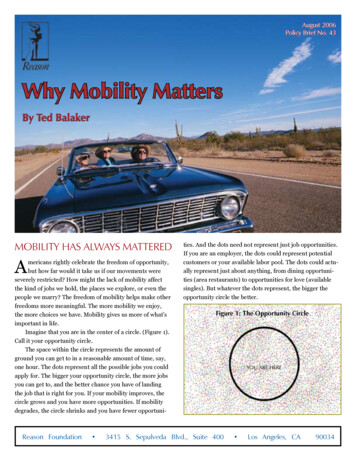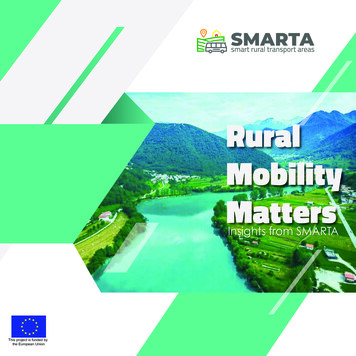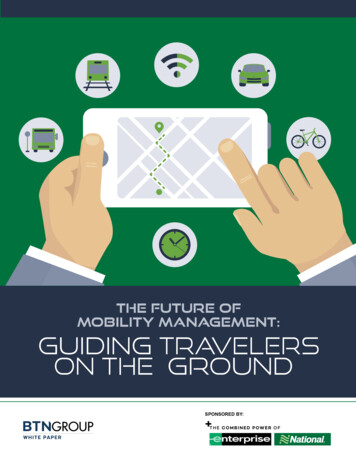
Transcription
The Future ofMobility Management:Guiding Travelerson the GroundSPONSORED BY:
Table of ContentsIntroduction3Realities Today and Future Timelines3Corporate Initiatives Today4Key Drivers of Change5Functions Tasked with Mobility Management6Next Steps and Conclusion7About this Survey8The Future of Mobility Management: Guiding Travelers on the Ground2
As 2020 began, a small number of cities around the world were starting tobenefit from mobility advancements. New technologies, transportationmodels and plans for public-private transit partnerships created a futurevision of convenient, eco-friendly transit alternatives for commuters, businesstravelers and urban dwellers.For the first time, travelers and commuters envisioned areality where a single app could assemble transportationsolutions to move them from home to office, hotel to clientmeeting and beyond.Travelers began to dream about a new reality in whichartificial intelligence curates the right mix of travel brandsand transportation methods, optimizing preferences—like,minimal travel time, low carbon footprint, lowest cost, ormaximum productivity.This future state simplifies and assembles the dizzying arrayof transportation options—on-demand car rentals, publictransit, shuttles, ride-hailing, ride-share, scooter and bikerentals—to a single point of access and transaction.While COVID-19 may have paused many commutes and mostbusiness travel, it has not eliminated the need for organizations toconsider and establish mobility strategies for the future.In fact, the World Economic Forum contends that workingfrom home has provided an “opportunity for companies,government entities and their employees to realize just howmuch valuable time and energy was previously spent on dailytravel.” Returning to offices, commuters and business travelerswill demand more.Early adopters have already started this journey. Othersare plotting visions for the next decade and beyond to useinnovative mobility technologies, business models andpartnerships to solve travel and commute issues. The modernTravel Manager and Human Resource professionals needto consider how the following external factors impact theirexisting and potential employees: Growing populations in urban areas The need for affordable, accessible transit available to all(social equity) A wider geographic footprint from which to drawprospective worker talent Corporate and individual responsibility to reducecongestion and carbon emissionsWhile automakers and other investors are working to developnew technologies for alternate power, autonomous vehicles,and closed infrastructures such as hyperloops, organizationsneed to begin strategizing now. According to the University ofMichigan, “optimizing transportation and mobility could resultin a tenfold reduction of motor vehicle fatalities and injuries,energy consumption and carbon emissions.”For corporations, mobility management changes could offerways to significantly enhance effectiveness and efficiency intravel management, fleet or ground transportation contracts.Mobility management in the future includes a holistic view ofemployee commuting, business travel, parking and supplierrelationships. Future partnerships would need to provide not onlythe integrated app to access a range of mobility services, butalso a reliable network of ground transportation options to serveemployees, business travelers, visitors and other stakeholders.Mobility management in the future could help corporationsmeet broader needs in sustainability and accessibility—andbetter guide employees about their options and duty of care.Data reporting in this new future of mobility would be inclusiveof all modes of transport—beyond car rental contracts to includetaxis, black car, public transit, ride-hailing, shuttles or more. Thiscomprehensive view will act as a tool for organizations to betterleverage or analyze spending and identify ways to enhanceservices, lower costs or better serve employees.REALITIES TODAY AND FUTURE TIMELINESMobility-as-a-Service (Maas) is operating in more than 20cities globally, according to a December 2019 Frost & Sullivanmarket forecast report. One of the first examples of Maas isfrom Helsinki, Finland starting in 2016. Helsinki governmentofficials’ goal was “to make it unnecessary for any city residentto own a private car by 2025,” according to Deloitte, whichdescribes Maas as “Netflix’s business model applied tourban transportation.” At the core of all Maas examples is a“digital platform that integrates end-to-end-planning, booking,electronic ticketing, and payment services across all modesof transportation, public or private.”1 Other such exampleshave emerged in Barcelona, Berlin, Eindhoven, Hanover, Paris,Singapore and Vienna.In the U.S., such examples are often called Mobility onDemand (MOD), as defined by the federal Departmentof Transportation. Denver, Las Vegas, Los Angeles and asmattering of other cities also have introduced initiatives.In its ten-year market forecast, Frost & Sullivan projectsthe Maas platform market to grow to 34.53 billion by1 Goodall, Warwick; Dovey, Tiffany; Bornstein, Justine; Bonthron, Brett, “The Rise of Mobility As A Service: Reshaping How Urbanites Get Around,” 2017,Deloitte Review Issue 20.The Future of Mobility Management: Guiding Travelers on the Ground3
2030, up from 61.3 million in 2018. “China is expected todemonstrate the highest compound annual growth rate of109% during this period, while regionally, North America willhave a market size of over 9 billion by 2030,” according tothe report. Rapid urbanization, increasing congestion andpollution reduction efforts will drive developments.City, state and federal governments often influenceavailable options. More than 15 countries and 20 citieshave approved regulations to restrict or ban the sale offuel-powered vehicles, starting in 2025 in Norway, 2026 inBelgium, 2027 in Austria and 2030 or beyond in the UnitedKingdom, Sweden, California and Canada. Some haveimposed taxes on private vehicles, taxis or ride-hailing carsin given areas to reduce pollution or congestion. Others haveattempted to enhance transit, mobility-on-demand or otheralternatives for residents.The global pandemic has stalled the growth for some,particularly ride-hailing, ride-sharing and public transit, oversafety and social distancing concerns. But such duty of careconcerns have provided new opportunities for rental carfirms and others that have emphasized their approachesto safety. For corporations and business travelers, safety,reliability and value are even more critical to travel decisionmakers. Whether to enhance safety or services, reducecarbon output, reduce costs or simplify traveler andemployee options, some companies are exploring waysto provide better guidance on ground transportation. “AsShifting TransportationFactors “On demand” vehicle usage is rising as new vehiclesales have been declining from a 2016 peak of 17.5million vehicles Electric and hybrid vehicle sales are growing—to325,000 in 2019, according to Edmunds.com, astraditional automakers, along with new venturesinvest billions into R&D and plans for nationwidecharging station networks, crucial to expansion Connected vehicles are providing data and servicesnever before envisioned Autonomous vehicles, hyperloops and even flyingcars (technically, vertical take-off-and-landing orVTOL) are in tests Transit agencies are rethinking the services, routesand demands of users The rise of app-based transportation options,whether ride-hailing, on-demand vehicles, ridesharing or carpools, on-demand bikes or scooters,continues in metro areas around the world Duty of care, social equity and decarbonizationconcerns are increasingCOVID-19 has brought nearly all travel to a standstill, nowis a particularly good time to reevaluate your existing travelpolicies,” noted CoreTrust Travel Solution Director ClaireLangford.In addition to highlighting initiatives of early adoptersin this space, the BTN Group from July to Octobersurveyed more than 200 corporate travel managementand procurement professionals responsible for travelmanagement about mobility management. Results, alongwith what advocates claim are the primary benefits tostakeholders and society of mobility management, areprovided in this white paper.WHAT ARE CORPORATIONS DOINGABOUT MOBILITY?In December 2019, the World Economic Forum profiled nearly20 companies that deployed sustainable commuting or productdistribution, such as low-carbon emission vehicles or deliverytrucks. Among the initiatives:BEDROCK & QUICKEN LOANS. In December 2018,Detroit-based commercial and residential real estatefirm Bedrock launched a program called MyCommute to“encourage Bedrock team members and visitors to Detroitto try alternative modes of transportation in response to anincreased demand for parking within the city,” accordingto the WEF’s “Corporate Mobility Transport Challenge.”In “collaboration with Quicken Loans and powered bycloud-based commute management software from Luum,the companies offered cash incentives and education toencourage use of alternative methods of transportation.”Alternative transportation options of bicycle, carpool, publictransit, ride-hail, vanpool and walking represented about14% of all commutes logged in the first 30 days. More than3,800 users logged at least one commute in the tool, and thecompanies reported that nearly 25% of the target audienceincreased usage of alternatives modes. Bedrock plans toexpand the program to its other locations in Cleveland andPhoenix. “Our goal is to deliver the best possible commuteexperience, and that starts each and every day with the tripdowntown. Bedrock embraces innovative transit programs,combined with easy access to varied mobility options, allcontributing to a more vibrant city,” stated Kevin Bopp,Bedrock Vice President, Parking and Mobility.BANK OF AMERICA. Bank of America offers low-carbonvehicle and workplace charging programs to employeesas part of its commitment to accelerate “the transition to asustainable, low-carbon economy.” In 2018, it offered 129chargers at 36 office premises in the United States, UnitedKingdom, Switzerland, the Netherlands, Turkey, the UnitedArab Emirates, France, China and Taiwan and doubled theemissions avoided as part of the program.The Future of Mobility Management: Guiding Travelers on the Ground4
LINKEDIN. In 2012, LinkedIn introduced RideIn to offer multiplecommute solutions to employees traveling from nine SanFrancisco Bay area counties to offices in Sunnyvale, MountainView and San Francisco. Mobility options include monthly transitsubsidies, last-mile shuttles to/from train stations, support forcycling or walking to work, vanpools, carpools and Wi-Fi-poweredlong-haul commuter buses. Electric vehicle charging stations,campus navigation and bikes are also part of the program. Thecompany encourages employees to “try an alternative commuteoption at least two days a week.” The program took off in 2019when LinkedIn RideIn “launched a free rides carpool pilot withScoop (managed carpool technology). It reported a 126%increase in average cars out of the parking lot” and more than2,500 carpool trips per week. Employees reported increasedproductivity, as well as new friendships. Registered users hadover 150,000 one-way matched trips that saved more than770,000 pounds of C02, according to Danielle Glaser of LinkedIn.ENEL. Brazilian multinational energy company ENEL developedan app to help employees pool corporate trips using a fleettelemetry taxi app and leasing system. Daily trips by workerswere inefficient and expensive with a taxi from Sao Paulo to othercities in the region costing up to 112.50 (R 450) and a daily carrental costing up to R 120. “An assessment showed that 18% ofcorporate journeys could be shared since they have very similardestinations. Mismanagement of resources available was notintentional, but rather a result of lack of information,” according toENEL’s Eduardo Bortotti. Within the app, the user chooses theroute, including origin and destination and the app determinesthe best travel mode. The app then books the trip and when itidentifies other users requesting a similar route, it directs bothto pool the trip. ENEL estimates a cost reduction of more than 300,000 (R 1.2million) per year in Sao Paulo.What Has Your Company Done Concerning Mobility Management?Started to discuss the needto establish enterprisemobility managementDecided thereis no need forsuch policiesor programsNeverheard ofthis before}43%12%}46%20%31%SURVEY SAYS: PART 2KEY DRIVERS OF CHANGEWithin business travel today, what are corporations doingabout mobility management?About 46% of respondents to a BTN Group Content Solutionssurvey said their organizations had either established orstarted to investigate the need to establish enterprise mobilitymanagement policies within their organization. Slightly fewer,43%, said they had either not considered, or never heard of thistopic. About 11% said their organizations decided there was noneed for such policies or programs.What Prompted This Discussion or Action Within Your Company?Directive to save moneyDirective to tighten policies26%11%THE BOSCH GROUP. Automotive technology and servicesfirm The Bosch Group encourages a culture of sustainablemobility to 55,000 employees in 15 locations in the Stuttgart,Germany region. As part of its Go for Mobility initiative launchedin January 2019, Bosch encourages use of bicycles, publictransportation, ride-sharing and corporate shuttles. Theprogram also offers a carpooling app with exclusive parkingspots for ride-sharers and it expanded shuttle bus service,equipped with Wi-Fi and app support. Bosch hired a consultantto include corporate mobility in long-term location masterplansand launched a communications campaign to educateemployees on sustainable mobility options for daily commutes.More than 12% of employees in the region registered forthe carpooling program in the first three months, when thecompany reported more than 2 tons of CO2 savings from suchrides. “We may be automotive suppliers, but specifically inconurbations we help our associates leave their cars at home,”stated Vokmar Denner, chairman of the board of policies53%37%Directive to rethink programs post-Covid30%Directive to strengthen relationships with key providers22%Directive to reduce carbon output15%Not considered this topicSource: BTN Group Content Solutions / Enterprise Holdings Transportation Mobility Management online survey of 209 corporate travel managers, July-October 2020The Future of Mobility Management: Guiding Travelers on the Ground5
Top Priorities Within Travel Programs Weighted average on 3-point scale with 1 as top priorityEnsuring employee health and safety1.34Saving money2.04Reducing number of suppliers2.29Reducing corporate carbon footprint2.33Expanding geographic footprint of providers2.44Getting travelers to book preferred suppliers/channels2.46Enhancing services to employees2.5Ground Transportation Options Identified in Corporate Policies, ProgramsCar rental94%Personal vehicle usage/mileage reimbursement for business use79%App-based transportation network providers, shared services64%Taxi55%Black car39%Public transit32%Chauffeured services31%Walking9%Bike rental6%Scooter rental5%Other-shuttle services, charters3%CURRENT PRACTICESReducing carbon output has been a key driver for governments,consortiums and companies that have embraced transportationmobility initiatives. In the Business Travel News “2020 State of theIndustry Report” editors noted that 24% of the 365 travel buyerrespondents to an online survey said climate change would pushtheir companies toward more sustainable business practicesafter COVID-19. “Consulting firm BCG is one company amongmany global counterparts that has put a great focus on reducingcarbon emissions. BCG is committed to reducing emissionsby 30% per employee by 2025,” Kathryn Bell, BCG managingdirector and partner, global operations services, told BTN editors.However, in the BTN Group mobility survey, respondents saidtheir advancements were driven more by ensuring employeehealth and safety, saving money and reducing the number ofsuppliers before reducing the corporate carbon footprint.There’s no question that the pandemic has made safetyand security leading concerns for all. For those contemplatingcar-sharing, ride-sharing or shared microbility (scooters, bikesor other one to two-person modes), less than 10% considerthem safe options, according to McKinsey’s Global COVID-19Automotive Consumer Survey, conducted in May 2020. In thatstudy, 81% said private vehicles were safe, while 55% saidwalking or private bike were safe.As for challenges to developing transportation mobilitymanagement policies and programs, BTN Group respondentssaid employee acceptance topped the list, as cited by about20%. That was followed by lack of resources or knowledge,cited by 18%. Time and figuring out how best to implementwere noted as obstacles by 15% or less.What resources could help to advance their initiatives?Benchmarking with other companies, best practices, studiesand internal commitments were the top responses. A handfulof respondents noted that they had hired consultants to helpguide their companies through the mobility journey.FUNCTIONS TASKED WITH MANAGINGENTERPRISE MOBILITYPerhaps due to the audience, but three-quarters of surveyrespondents said travel management is the function chargedwith mobility management, followed by procurement at 37%,safety/security/risk management at 28% and finance at 25%respondents.Within managed travel, the biggest spending categoriesof air and hotel have historically gotten the most attention.However, as travel and procurement managers have focusedon optimizing every dollar of spend, particularly in matureprograms where savings are sometimes harder to seek outyear-after-year, some have intensified their focus on otherspend categories such as ground transportation, whichtypically comprises less than 10% of total spend.In addition, some have intensified their efforts to better corralground transportation spending due to its highly fragmentednature: often a combination of car rental, taxi, ride-hailing, blackcar, chauffeured services, public transit and even scooter andThe Future of Mobility Management: Guiding Travelers on the Ground6
Post-COVID Policy Changes Has your company implemented, or do you expect toimplement, any of the following policy changes post-Covid?Pre-trip approvals of all business travelStrength of Ground Transportation Provider InfluenceHow strongly does your organization influence groundtransportation provider selection in the company travelpolicy, travel apps, booking and expense tools?62%Use of preferred suppliersis mandatedIncreased options for travelers to drive using personal or rental car40%Increased emphasis on use of preferred suppliers, but not mandated30%6%6%37%Mandated use of preferred suppliers19%Increased flexibility for travelers to decide suppliers12%58%We do not attemptto influencedecisionsWe do not havepreferred groundtransportationsuppliersUse of preferredsuppliers is encouraged,but not requiredSource: BTN Group Content Solutions / Enterprise Holdings Transportation Mobility Management online survey of 209 corporate travel managers, July-October 2020bicycle rentals. For duty-of-care, companies may want to morecarefully review supplier qualifications, global footprints, safety andcleaning practices. However, respondents in our survey indicatedthat many policies addressed only car rental, reimbursement ofpersonal vehicles for business use, app-based ride-hailing or taxis.Less than half of the respondents said their policies or expensereimbursement guidelines covered black car, chauffeured services,public transit, bicycle or scooter rentals, shuttles or walking.POLICIES AND MANDATESPost-Covid, survey respondents indicate that some, thoughnot all, companies have tightened travel policies, implementedmultiple levels of pre-trip approvals—at least for now—and even mandated use of specific suppliers that meet acompany’s safety and security concerns.POLICIES FOCUS ON AIR-HOTEL TRIPSWhen asked if company policies or programs address travel toand from work and home, fewer than 20% said their initiativescurrently address such commutes. The vast majority ofpolicies covered travel to airports, rail stations, hotels,meetings or appointments, respondents said. When asked ifthey thought the policies should cover commutes, fewer than5% of respondents so indicated.NEXT STEPS AND CONCLUSION“In order to move forward, companies should invest the resources– financial, human and time – to conduct a thorough examinationof their current transportation practices,” according to the WorldEconomic Forum Corporate Mobility Transport Challenge. “Gathering information through surveys, employee, supplier and customerinterviews and other tools is crucial in crafting an appropriateresponse. Here, context and intersectionality are also important.”Post-Covid, it’s clear many companies will be taking a closerlook at all polices, practices and spending. For many, a goodstarting point may be a deep data dive to thoroughly understand the company’s total spend on ground transportation,including car rental, ride-hailing and beyond.Travel Managers have the opportunity to take active roles in thedevelopment of company-shaping mobility management initiatives: Initiate conversations with internal stakeholders, includinghuman resources, fleet management, risk and seniorleaders, about the organization’s priorities. As mobilitymanagement benefits, including carbon output, inclusionand urban planning are identified, offer to provide insightsor to participate in associated committees. Engage preferred suppliers about the mobility managementoptions they offer or expect to emerge in coming years. Learn what government officials in your headquartercity (and/or top destination markets) are planning in thecoming years. Compare survey responses with industry colleagues tohelp establish appropriate benchmarks. Review your policies, guidelines or mandates, preferredsupplier relationships and booking and expense tools toensure they reflect the current priorities of your organization.Austin Brown, UC Davis expert and member of the GlobalMobility Coalition articulated it simply: “The global communityis demanding better from our transportation systems: we wantthem to be more efficient, more equitable, and less polluting.Getting this right will take a diverse array of research, businessand policy voices.” The Future of Mobility Management: Guiding Travelers on the Ground7
Business Travel Spending of RespondentsSurvey MethodologyBTN Group Content Solutions fielded an online survey about21%transportation mobility management from July to October 2020.30%Of the 209 respondents responsible for corporate travel, 65%identified themselves as travel manager, director, vice presidentor other managers; 20% said they were procurement managers,20%directors or analysts; and 15% said they were other corporate29%executives responsible for travel. The survey and white paperwere sponsored by Enterprise Holdings. 50 million or more 10 million to 49.9 million 3 million to 9.9 millionLess than 2.9 millionThis white paper was created by Northstar Travel Group, LLC and paid for by Enterprise Holdings, Inc. The content of this white paper wasdeveloped solely by Northstar Travel Group, LLC, and all views and opinions contained herein are strictly those of Northstar Travel Group,LLC. Enterprise Holdings, Inc. and its affiliates and do not necessarily endorse the content contained herein.PRODUCED BY:Mary Ann McNultyExecutive Director,Content Solutionsmmcnulty@thebtngroup.comJen BankardDirector, Content Solutions& Conferencesjbankard@thebtngroup.comLouis MagliaroExecutive Vice President& Group Publisherlmagliaro@thebtngroup.comLindsay StraubAssociate Publisherlstraub@thebtngroup.comMariza MoreiraGroup Design ManagerAbout Enterprise HoldingsEnterprise Holdings isn’t just the world’s largest car rental operator. We’re also anindustry leader in mobility and technology, as well as one of the top global travelcompanies. Through a global network that operates in nearly 100 countries andterritories, we provide extensive vehicle rental, carsharing, truck rental, fleet management, retail car sales, as well as travel management and other transportationservices to make travel easier and more convenient for customers. Privately heldby the Taylor family of St. Louis, our financial strength and stability are unmatchedin our industry. No matter what transportation challenges our customers face, wehave an innovative solution that takes them where they need to go.For more information about Enterprise Holdings Inc.,visit www.enterpriseholdings.com.Angelica MundrickGraphic DesignerThe Future of Mobility Management: Guiding Travelers on the Ground8
mobility to 55,000 employees in 15 locations in the Stuttgart, Germany region. As part of its Go for Mobility initiative launched in January 2019, Bosch encourages use of bicycles, public transportation, ride-sharing and corporate shuttles. The program also offers a carpooling app with exclusive parking }} enterprise mobility management


